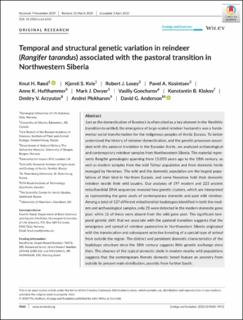| dc.contributor.author | Røed, Knut | |
| dc.contributor.author | Kvie, Kjersti | |
| dc.contributor.author | Losey, Robert J. | |
| dc.contributor.author | Kosintsev, Pavel A | |
| dc.contributor.author | Hufthammer, Anne Karin | |
| dc.contributor.author | Dwyer, Mark J. | |
| dc.contributor.author | Goncharov, Vasiliy | |
| dc.contributor.author | Klokov, Konstantin B | |
| dc.contributor.author | Arzyutov, Dmitry V. | |
| dc.contributor.author | Plekhanov, Andrei | |
| dc.contributor.author | Anderson, David G. | |
| dc.date.accessioned | 2021-05-18T12:30:13Z | |
| dc.date.available | 2021-05-18T12:30:13Z | |
| dc.date.created | 2021-01-15T11:31:59Z | |
| dc.date.issued | 2020 | |
| dc.Published | Ecology and Evolution. 2020, 10 (17), 960-1072. | |
| dc.identifier.issn | 2045-7758 | |
| dc.identifier.uri | https://hdl.handle.net/11250/2755494 | |
| dc.description.abstract | Just as the domestication of livestock is often cited as a key element in the Neolithic transition to settled, the emergence of large‐scaled reindeer husbandry was a fundamental social transformation for the indigenous peoples of Arctic Eurasia. To better understand the history of reindeer domestication, and the genetic processes associated with the pastoral transition in the Eurasian Arctic, we analyzed archaeological and contemporary reindeer samples from Northwestern Siberia. The material represents Rangifer genealogies spanning from 15,000 years ago to the 18th century, as well as modern samples from the wild Taĭmyr population and from domestic herds managed by Nenetses. The wild and the domestic population are the largest populations of their kind in Northern Eurasia, and some Nenetses hold their domestic reindeer beside their wild cousins. Our analyses of 197 modern and 223 ancient mitochondrial DNA sequences revealed two genetic clusters, which are interpreted as representing the gene pools of contemporary domestic and past wild reindeer. Among a total of 137 different mitochondrial haplotypes identified in both the modern and archaeological samples, only 21 were detected in the modern domestic gene pool, while 11 of these were absent from the wild gene pool. The significant temporal genetic shift that we associate with the pastoral transition suggests that the emergence and spread of reindeer pastoralism in Northwestern Siberia originated with the translocation and subsequent selective breeding of a special type of animal from outside the region. The distinct and persistent domestic characteristics of the haplotype structure since the 18th century suggests little genetic exchange since then. The absence of the typical domestic clade in modern nearby wild populations suggests that the contemporary Nenets domestic breed feature an ancestry from outside its present main distribution, possibly from further South. | en_US |
| dc.language.iso | eng | en_US |
| dc.publisher | Wiley | en_US |
| dc.rights | Navngivelse 4.0 Internasjonal | * |
| dc.rights.uri | http://creativecommons.org/licenses/by/4.0/deed.no | * |
| dc.title | Temporal and structural genetic variation in reindeer (Rangifer tarandus) associated with the pastoral transition in Northwestern Siberia | en_US |
| dc.type | Journal article | en_US |
| dc.type | Peer reviewed | en_US |
| dc.description.version | publishedVersion | en_US |
| dc.rights.holder | Copyright 2020 The Authors | en_US |
| cristin.ispublished | true | |
| cristin.fulltext | original | |
| cristin.qualitycode | 1 | |
| dc.identifier.doi | 10.1002/ece3.6314 | |
| dc.identifier.cristin | 1871973 | |
| dc.source.journal | Ecology and Evolution | en_US |
| dc.source.40 | 10 | |
| dc.source.14 | 17 | |
| dc.source.pagenumber | 9060–9072 | en_US |
| dc.relation.project | ERC-European Research Council: 295458 | en_US |
| dc.relation.project | Nordforsk: 76915 | en_US |
| dc.identifier.citation | Ecology and Evolution. 2020, 10 (17), 9060–9072. | en_US |
| dc.source.volume | 10 | en_US |
| dc.source.issue | 17 | en_US |

